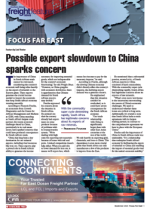As global trade continues to evolve, the shipping industry is experiencing a significant shift in focus towards establishing new direct services connecting Southeast Asia and the Indian subcontinent into Africa.Eva Rasmussen, general manager for ocean freight at SACO CFR, says there is potential for growth into East and West Africa via South Africa.With this perspective in mind, the company has extended its footprint in East and West Africa by inaugurating new offices in the region. The next office will be SACO Shipping Senegal, which will open its doors for business later this month. "This expansion enables us to enhance our service offerings from the Far East to Africa. Logistics companies must remain agile in an ever-evolving and fiercely competitive market," she told Freight News."Delivering direct services that entail reduced handling and improved transit times is pivotal in meeting our clients' expectations and requirements." This is the rationale behind SACO CFR's decision to modify one of its direct import services. "We are shifting our import service offering from Guangzhou to Nansha, China. Our clients stand to gain from more competitive pricing and shorter transit times, further bolstering shipments from across the entire Pearl River Delta," she says.According to Rasmussen, there has been a notable shift in the sourcing of commodities. "Traditionally, Chinese products are now being sought from other Far East origins or even the Indian subcontinent. Furthermore, we are observing a decrease in demand for goods, and warehouses continue to grapple with overstocked inventories. The decline in commodity prices and a decrease in external demand, particularly in China, have contributed to this shift in export trends."Rasmussen says the traditional peak seasons for shipments from Asia to South Africa appear to be waning due to decreased consumer demand. Moreover, there’s continued freight rate volatility, depending on the carrier and the point of origin. "We've observed shorter pricing validities being offered, and spot rates are prioritised over long-standing contractual agreements in the current landscape."According to Rasmussen, carrier sailing schedules are one of the most significant challenges encountered from the Far East. "Frequently, we are confronted with blank sailings as carriers strive to stimulate demand and ensure optimal vessel capacity utilisation. With the introduction of more Ultra Large Container Vessels into a market characterised by low demand, carriers face a formidable task in managing their capacity effectively," she says. "Another significant challenge we encounter relates to accepting and handling hazardous cargo. Carriers are implementing more stringent acceptance processes, which can be particularly challenging in a time-sensitive market. NVOCCs need to be f lexible to accommodate hazardous cargo requests from the freight forwarding community, and thereby the consolidation containers often change based on shifting demand in size and quantity.This f lexibility in the NVOCC market becomes a complex process from the carrier's perspective when there are alterations in hazardous classes and container sizes. Hazardous shipments may be added or split into multiple containers at the last minute, placing additional demands on the carrier's hazardous materials compliance teams for timely approval before cargo delivery and loading.Despite the challenges, Rasmussen is optimistic. "The Far East remains a prominent player in the global trade arena, with China leading its development. Additionally, the expanded invitation to include five more countries in Brics as well as the African Union being accepted as part of the G20, should benefit the global trade forecast well. Moreover, we continue to witness investments f lowing from the Far East into South Africa, which will ultimately bolster South Africa's own development."

